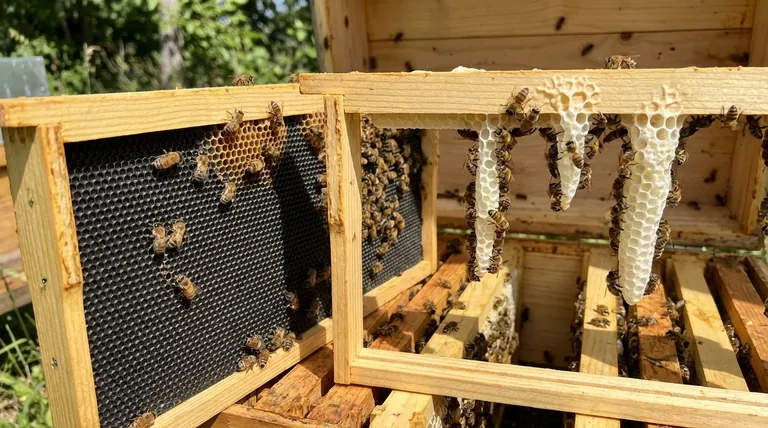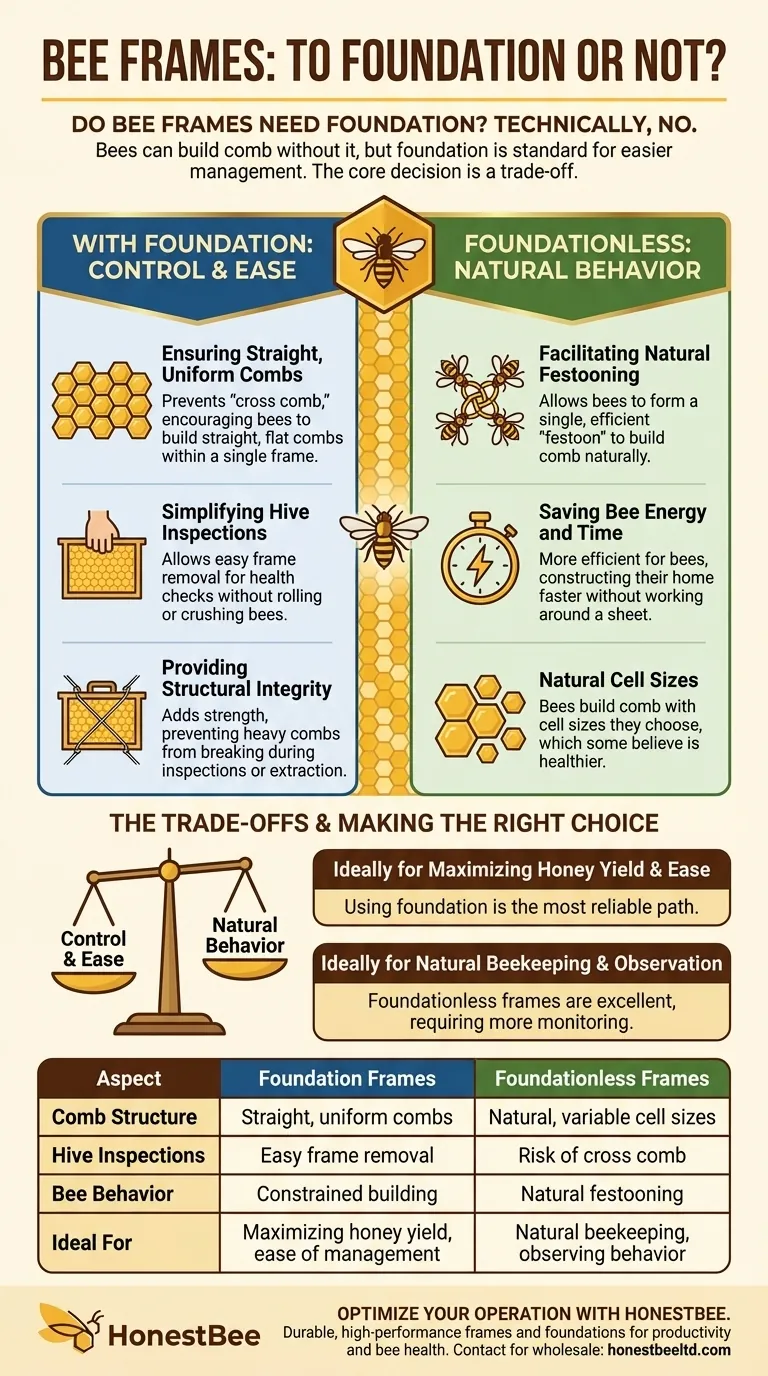Technically, no. Bee frames do not require foundation to function. Bees are perfectly capable of building their own comb without any guide. However, using foundation is a standard practice in modern beekeeping because it makes managing the hive significantly easier and more predictable.
The core decision is a trade-off: foundation offers control and ease of management for the beekeeper, while foundationless frames allow bees to follow their natural instincts, which can require more diligent oversight.

The Role of Foundation in a Managed Hive
Foundation was developed to solve specific problems that arise when keeping bees in a man-made hive. It imposes a structure that benefits the beekeeper during inspections and harvests.
Ensuring Straight, Uniform Combs
Without a guide, bees may build "cross comb," connecting wax between adjacent frames. Foundation provides a clear blueprint, encouraging bees to build straight, flat combs that are contained within a single frame.
Simplifying Hive Inspections
Straight combs are crucial for easy removal and replacement of frames. This allows beekeepers to inspect the colony's health, check for the queen, and assess food stores without rolling or crushing bees, which can trigger defensive behavior.
Providing Structural Integrity
Foundation, especially when wired or made of plastic, adds significant strength to the comb. This structural support prevents combs heavy with honey from breaking during inspections or extraction, particularly in warmer climates.
Why Bees Often Prefer Foundationless
While foundation helps the beekeeper, it alters the bees' natural building process. Going foundationless allows bees to construct their comb as they would in a wild setting.
Facilitating Natural Festooning
Bees build comb by hanging together in chains, a behavior called "festooning." Foundation acts as a barrier, forcing them to form two separate festoons on either side. A foundationless frame allows them to create a single, more efficient curtain of bees.
Saving Bee Energy and Time
Building comb from a single festoon is a more natural and efficient process for the bees. By not having to work around a pre-made sheet, they can construct their home faster and with less energy expenditure.
Understanding the Trade-offs
Choosing whether to use foundation involves weighing the benefits of control against the advantages of natural bee behavior.
Foundation: Control vs. Constraint
Foundation gives you predictable, interchangeable frames perfect for honey extraction and simple inspections. However, it forces bees to build on a predetermined template and can be less efficient for them.
Foundationless: Natural Behavior vs. Management Challenges
Foundationless beekeeping allows bees to build comb with cell sizes they choose, which some proponents believe is healthier for the colony. The major downside is the increased risk of cross comb, which can make hive inspections difficult and destructive if not managed carefully.
Making the Right Choice for Your Goal
Your beekeeping philosophy and objectives should guide your decision. There is no single "best" answer, only what is best for your specific situation.
- If your primary focus is ease of management and maximizing honey production: Using foundation is the most reliable and straightforward path.
- If your primary focus is natural beekeeping and observing bee behavior: Foundationless frames are an excellent choice, provided you are prepared for more intensive monitoring to correct any cross comb.
Ultimately, understanding this choice empowers you to build a hive that aligns with both your goals and the well-being of your bees.
Summary Table:
| Aspect | Foundation Frames | Foundationless Frames |
|---|---|---|
| Comb Structure | Straight, uniform combs | Natural, variable cell sizes |
| Hive Inspections | Easy frame removal | Risk of cross comb |
| Bee Behavior | Constrained building | Natural festooning |
| Ideal For | Maximizing honey yield, ease of management | Natural beekeeping, observing behavior |
Optimize your beekeeping operation with the right equipment. Whether you manage a commercial apiary or distribute beekeeping supplies, HONESTBEE provides durable, high-performance frames and foundations designed for productivity and bee health. Contact our wholesale experts today to discuss bulk pricing and tailored solutions for your needs.
Visual Guide

Related Products
- Food Grade Plastic bee Foundation for Bee Frames
- Colorful Silicone Beeswax Foundation Mold Mould for Beekeeping
- Durable Galvanized Steel Frame Grip
- Beeswax Foundation Sheets Beehive Foundation for Wholesale
- Professional Long-Handled Silicone Honey Scraper for Beekeeping
People Also Ask
- Why do commercial beekeepers prefer plastic foundation? Durable, Reusable, and Cost-Effective
- How do you get bees to draw out plastic foundation? Master the Art of Comb Building
- Why is it beneficial to coat plastic foundation with beeswax? Boost Hive Acceptance & Comb Building
- How to get bees to use plastic foundation? Master the Wax Coating and Resource Strategy
- What additional step can improve the performance of plastic foundation in the hive? Apply a Generous Coat of Beeswax



















